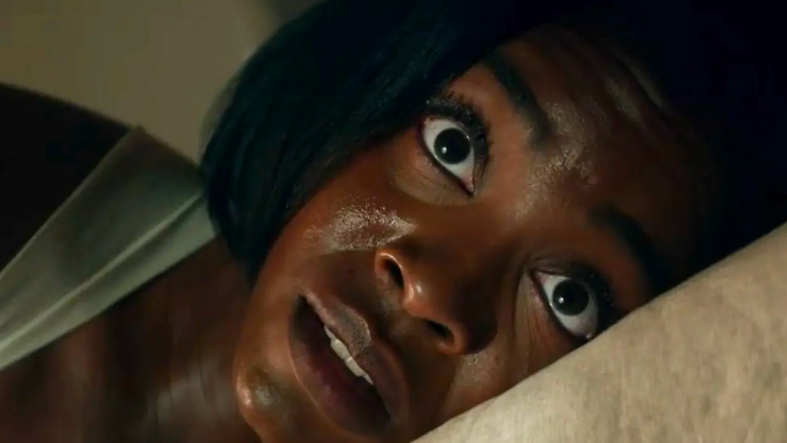Terror and Trauma: Revisiting Prime Video’s ‘Them’ 2 Years Later

I first caught Little Marvin’s Them (which, when I Google, is regularly mistaken for either the French home invasion thriller or classic giant ant movie of the same name) out of the 2021 South by Southwest Film Festival. Festivals will regularly preview new television shows, and as part of that year’s slate, the first three episodes of Them were available to stream. By the time the third episode ended, I was convinced it was one of the scariest things I’d ever seen.
In anticipation of this piece, I revisited select episodes, but not the entire series. My assessment still stands. On a pure, primal level, Them is terrifying. It’s more visceral, more physical, more dig-deep-into-the-marrow distressing than any contemporary horror show. It’s also, to put it kindly, trauma porn, a show so imbued with racial tragedy and violence, it risks genuinely harming and re-traumatizing Black audiences. That triggering has been documented, with Robeson Taj Frazier, USC professor and director of the Institute for Diversity and Empowerment, noting, “We’re living and having to navigate the constant terrorization of Black bodies and the destruction of our flesh and then having to endure that while you think you’re watching escapist fare in your house.”
Also Read: Are You Okay, Girl?: 10 Movies That Underutilized Black Women
Stephen King—yes, that Stephen King—remarked that Them’s premiere episode “scared the hell out of me.” Like me, King was seeing a worldview that was both familiar and foreign. Mark Anthony Neal, chair of the African and African American studies department at Duke University, said, “For white audiences, these projects offer an opportunity to see things they may not see on a regular basis, while for Black folks, it’s the same old, same old. People are really sensitive and raw about the graphicness of the violence because, for them, it’s not entertainment.”
Structurally, from a perspective of pure craftsmanship, Them is remarkable. It’s gorgeously shot, meaningfully staged, and chock full of powerhouse performances, most notably from both Deborah Ayorinde as Livia “Lucky” Emory and Shahadi Wright Joseph (also seen in Jordan Peele’s Us) as Ruby Lee Emory. The first two episodes especially unfurl as a kind of riff on The Conjuring, maybe even Poltergeist. It’s ostensible domestic bliss that’s immediately intruded upon when the Emory family relocates to an all-white neighborhood. The scares are simultaneously social and supernatural, with the more conventional jolts attributed to unseen specters.
When Lovecraft Country premiered on HBO, mostly white audiences were introduced, for the first time, to the history of sundown towns, racially segregated towns whose names stemmed from signs that regularly urged, under threat of violence, Black people to leave before the sun went down. It’s a noxious mark on history whose wounds persist today. Yet for a swath of the audience wanting escapist HBO genre fare, it was a lesson, a sobering reminder of a hidden history they knew nothing about.
Also Read: Black Horror Freelancers Share Their Experience In The Field
Them socially orbits around housing covenants—“clauses that were inserted into property deeds to prevent people who were not White from buying or occupying land,” according to the University of Minnesota—and the Federal Housing Administration’s resistance toward moving Black families into white neighborhoods for fear it would reduce property values. According to NPR, while this widely held belief endured for years, it (surprise) had no basis in any measurable data or trend.
As illustrated by Them, these neighborhoods were far from safe. The Emory family contends not only with supernatural threats, but racial ones as well, whether at work, school, or neighbors, including Betty (Alison Pill), whose animosity and acts of violence swell throughout the 10-episode series. Another surprise, The Guardian reported in 2018 that this kind of racial segregation (and violence) hasn’t gone anywhere. In a largely white neighborhood, Black families are only marginally safer today than they have been historically.
Also Read:
Dewayne And Black Queer Horror Excellence In ‘The Blackening’ [The Lone Queer]
Which, to return to Them and its 10-or-so hours of unrelenting terror, begs the question; when is too much, well, too much? Them is terrifying, and I’d still argue it’s one of the scariest pieces of media released in over a decade. There’s a tactility, a viciousness, to its horror that isn’t regularly seen. Yet, even revisiting it for this piece, there were beats or entire episodes I skipped over entirely. I couldn’t bear to watch them again. Imaginably, that reluctance would be compounded for Black audiences reasonably tired of seeing their stories reduced to what some critics contend is racial horror porn.
Critically, it makes for a tough, almost impossible assessment. Both Stephen King and I agree Them is terrifying. I think it’s one of the scariest things ever made. Yet, concurrently, it feels irresponsible. Even with the most forgiving lens of media literacy applied, I struggle to come up with why, beyond traumatizing viewers, it exists in the form it does. Maybe that’s the point of horror—maybe there doesn’t need to be any other reason. Creatives, after all, urgently need the liberty to tell the stories they want to tell the way they want to tell them. All we can do is spearhead the conversation, assess them, contextualize them, and maybe never want to revisit them again.
Categorized:Editorials

